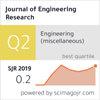乳液膜去除水中的呋塞米:实验条件和实际水质的影响
IF 0.9
4区 工程技术
Q3 ENGINEERING, MULTIDISCIPLINARY
引用次数: 0
摘要
研究了乳状液膜法(ELM)对低pH水相中速尿(FSM)的去除效果。考察了表面活性剂浓度、稀释剂类型、溶出液浓度、进料液pH、溶出液/膜液体积比、乳化时间和速度、搅拌速率、溶出液初始浓度、乳化液/进料液体积比等实验条件对FSM渗透速率和乳状液稳定性的影响。考察了在不同的自然复矩阵中提取FSM的能力。以Span 80 (5% w/w)为表面活性剂,己烷为稀释剂,NaOH(0.01 N)为汽提剂,汽提液/膜液体积比为1/1,处理体积比为20/200,混合速率为200 rpm组成ELM体系。处理过程表明,在20 min的极短时间内完全去除FSM。在海水和天然矿泉水中,萃取时间为20 min,萃取效率分别为94.3%和96.8%。此外,据报道,FSM的剥离效率非常好(100%),表明ELM从水中去除和回收FSM的能力非常出色。由于这些原因,ELM技术是处理fsm污染水的一种特别有趣的方法。本文章由计算机程序翻译,如有差异,请以英文原文为准。
Removal of furosemide from water by emulsion liquid membrane: Influence of experimental conditions and real water matrices
This work investigates the removal of furosemide (FSM) from low pH aqueous phase by emulsion liquid membrane (ELM). The influence of various experimental conditions on FSM permeation rate and subsequent emulsion stability, such as surfactant concentration, diluent type, stripping solution concentration, feed solution pH, stripping solution/membrane solution volume ratio, emulsification time and speed, stirring rate, initial FSM concentration, and emulsion/feed solution volume ratio, was evaluated. The ability to extract FSM in different natural complex matrices was examined. The ELM system is formed by Span 80 (5% w/w) as surfactant, hexane as diluent, NaOH (0.01 N) as stripping agent, stripping solution/membrane solution volume ratio of 1/1, treatment volume ratio of 20/200, and mixing rate of 200 rpm. The treatment process demonstrates complete removal of FSM within a remarkably short time span of 20 min. In seawater and natural mineral water, the extraction efficiency is 94.3% and 96.8%, respectively, after 20 min. Additionally, the stripping efficiency of FSM is reported to be excellent (100%), demonstrating the remarkable ability of ELM to remove and recover FSM from water. For these reasons, the ELM technique is a particularly interesting process for treating FSM-contaminated water.
求助全文
通过发布文献求助,成功后即可免费获取论文全文。
去求助
来源期刊

Journal of Engineering Research
ENGINEERING, MULTIDISCIPLINARY-
CiteScore
1.60
自引率
10.00%
发文量
181
审稿时长
20 weeks
期刊介绍:
Journal of Engineering Research (JER) is a international, peer reviewed journal which publishes full length original research papers, reviews, case studies related to all areas of Engineering such as: Civil, Mechanical, Industrial, Electrical, Computer, Chemical, Petroleum, Aerospace, Architectural, Biomedical, Coastal, Environmental, Marine & Ocean, Metallurgical & Materials, software, Surveying, Systems and Manufacturing Engineering. In particular, JER focuses on innovative approaches and methods that contribute to solving the environmental and manufacturing problems, which exist primarily in the Arabian Gulf region and the Middle East countries. Kuwait University used to publish the Journal "Kuwait Journal of Science and Engineering" (ISSN: 1024-8684), which included Science and Engineering articles since 1974. In 2011 the decision was taken to split KJSE into two independent Journals - "Journal of Engineering Research "(JER) and "Kuwait Journal of Science" (KJS).
 求助内容:
求助内容: 应助结果提醒方式:
应助结果提醒方式:


